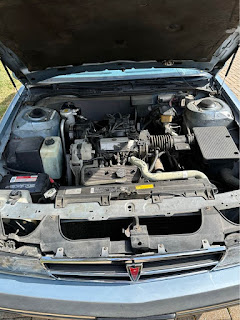What killed off the dinosaurs? It's been surmised that 66-million years ago, a 50-mile wide, 110-trillion-ton meteor known as the "Chicxulub Impactor" crashed into Earth off what is now the Pacific coast of Mexico leaving a crater 90-miles wide and 12-miles deep. Its collision caused massive tsunamis, wildfires and a cloud of debris and aerosols that led to the eventual extinction of most life on earth, including almost all dinosaurs.
What killed off giant station wagon's, however, was just as succinct although the metaphorical meteor that struck the wagon market, Chrysler's 1984 minivans, were a heck of a lot smaller than the "Impactor". One of the giant station wagons it eventually smothered out of existence was Buick's Estate Wagon. Our lovely subject here is a 1986 Buick LeSabre Estate wagon.
Through 1989, Buick had two "Estate Wagons", there was s LeSabre and a plushier trimmed Electra Estate; after 1990 Buick wagons were simply, "Estate Wagons". The difference between them basically interior trim baubles and bits - the cars were the same underneath. Buick blurring the lines further selling LeSabres with the woodie-wallpaper like our '86 here has. It's a look you either "get" or think as goofy as sneakers worn with high-end dress suits like the sports wonks on TV do.
Seeing how long it took GM and Ford to come out with front-wheel-drive minivans of their own, Ford in 1989 and GM in 1990, you'd think The Big Two were asleep at the minivan wheel. Truth is, they weren't - they quickly returned fire by 1985 but their recipes for a mini-van were decidedly different than Chrysler's - they both based their vans on existing, compact pickup trucks. And there was a universe of difference between a car-based minivan like the Chrysler's were and the truck-based ones Ford and GM pushed out.
Therefore, seeing how half-arsed their attempts were at a "mini", it's fairly easy to see why GM (and Ford) continued to sell car-based station wagons like our '86 LeSabre Estate here; they didn't take Chrysler seriously. Problems rose quickly as their truck-based minis failed to take off in sales and their wagon sales began imploding. Meanwhile Chrysler rode the lack of competition all the way to the bank.
As a young twenty-something with little interest in wagons at the time, I found it fascinating to witness the metamorphosis of the family truckster from a "mom-mobile" to something that screamed "mom-mobile" even more.
Ford's 1989 car-based Windstar was a better salvo than the Ranger-based Aerostar but it had only minor impact on Chrysler minivan sales. GM answered back with their laughable "Dustbuster" minivans in 1990, they too had little effect on the mighty Chrysler's. While GM refined their minivans over the years, they never quite got the recipe right. Ford too for that matter.
Personally, if I was of family-rearing age at the time, I'd have gone for a GM wagon and if I had the means, one like this. Even resplendent in "woodie-guise". Part of GM's class of 1977 downsized full sizers, these handled with an aplomb the glorious, oversized wagons of yore could only dream about, if cars, in fact, could dream.
Our 34,000-mile '86 here is for sale on FB Marketplace with a more than reasonable asking price of $9995. Get it closer to $7,500 and put the savings towards a crate engine, it's phleghmy, 150-horsepower (if that) Olds-built V-8 has to go, or, heaven forbid, an LS swap to turn it into the sleeper of carpool lane nightmares.













































